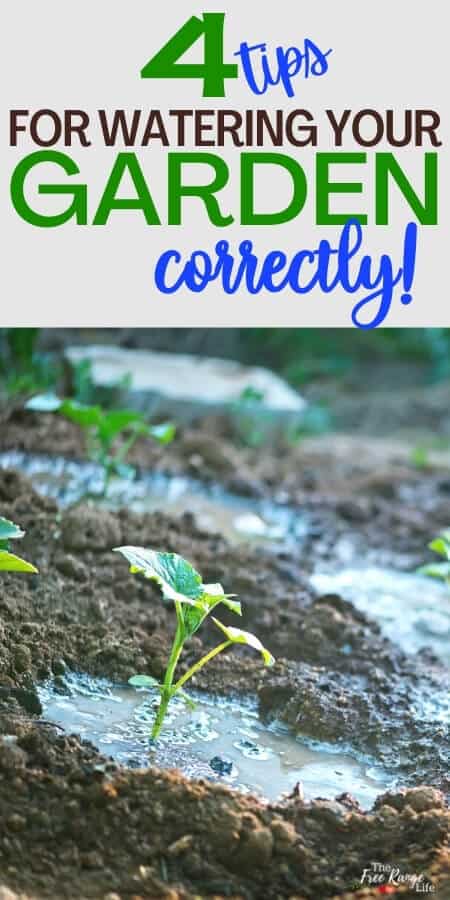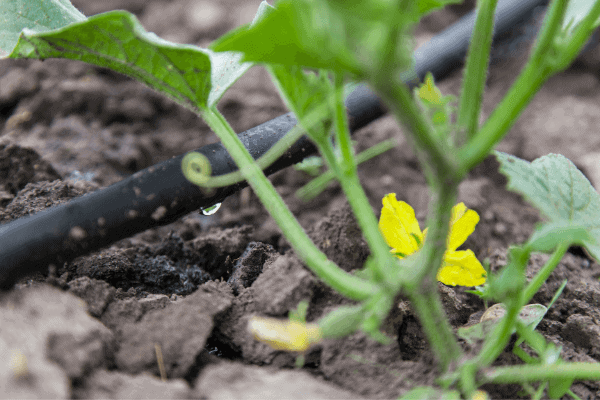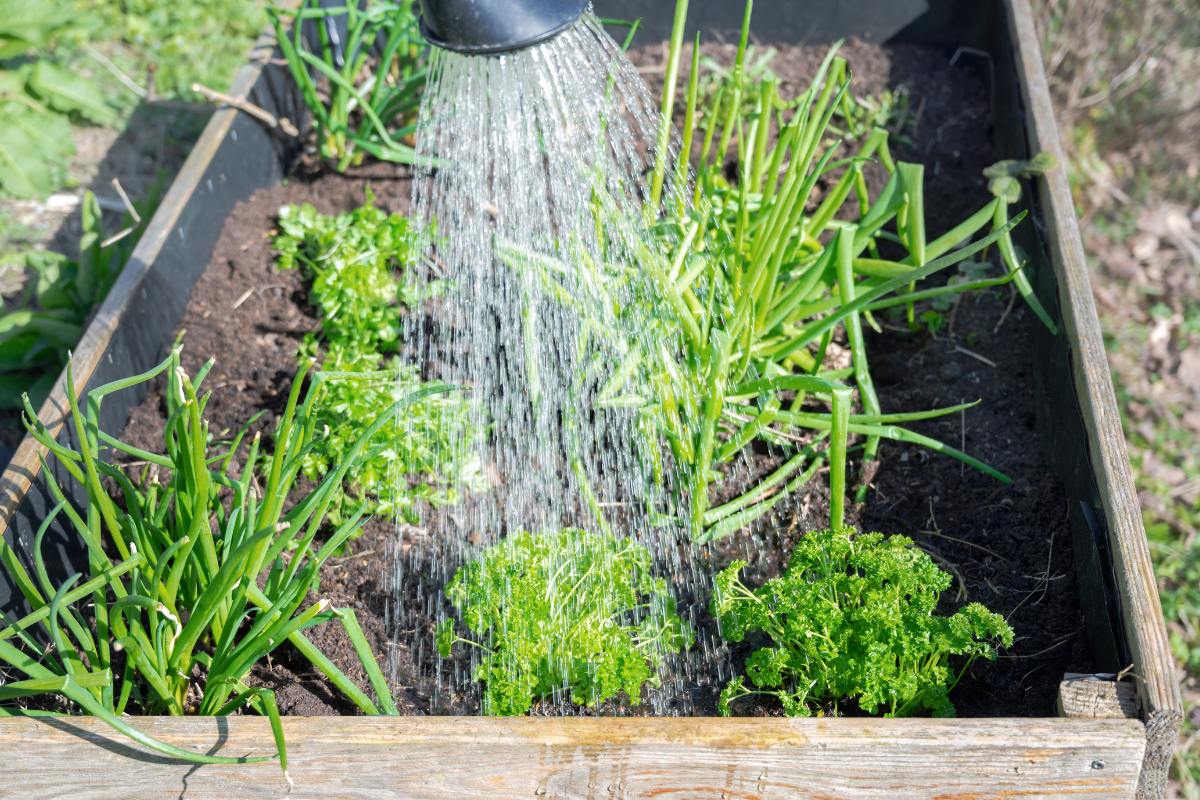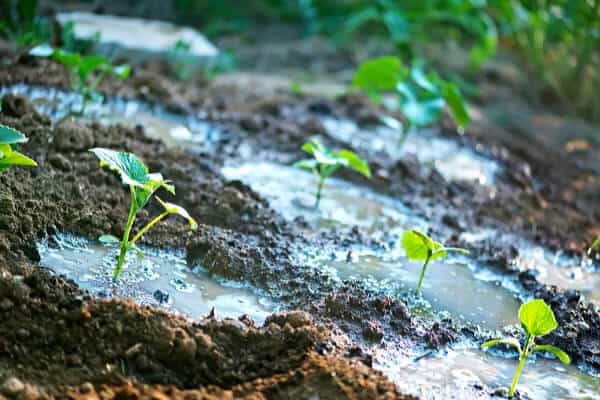Is your garden suffering because you don’t know how to water it correctly? Learn how to water your garden correctly, including the best time to water your garden and how often to water your garden!
When it comes to seed starting and gardening, many of the problems gardeners encounter are a product of incorrect watering.
This site contains affiliate links. If you make a purchase using one of these links, I may earn a commission. Please see my disclosure page for more information about cookies collected and our privacy policy.
It’s the most common problem I see when fielding questions about seed starting- either they are getting too much water and drowning, rotting, or molding or they are not enough water to germinate and thrive.
Out in the garden improper watering can lead to wilting from not enough water or problems with things like disease or root rot from too much water.
How to Water Your Garden Correctly
There are a few things to consider when watering your garden. These include your basic questions: how, where, when, and how often. So let’s take a look at these 4 pieces so you can be sure you’re watering the correct way and for the best results.
First, let’s look at how and where. There actually is a right and wrong way to water your garden. And the common use of a garden sprinkler is actually the wrong way to do it.
By using a sprinkler, you will be getting water on the tops of the plants as opposed to the roots of the plants. This can both waste water and promote disease in your crops. Instead use a soaker hose, drip irrigation system, or manually water using your hose- but focus on the soil not the air.
Also make sure you are watering deeply with each session and not just wetting the surface. Remember that dry soil won’t absorb as quickly as wet soil, so watering slowing can help reduce runoff and ensure your crops get the water they need.
Next, when. You should be watering your garden only as needed. Too much water can actually cause the roots to rot- which isn’t what you want. Most plants will send roots down deep into the soil to search for the ground water- and that’s what you want them to do.
You also want to make sure you are getting the most out of your watering sessions- which means not watering in the heat of the day when water will evaporate. Secondly, you always want to make sure any water that does end up on the leaves has plenty of time to dry in the sun so in order to prevent disease.
Finally- how often should you water your garden? As I stated above you should only water your garden as needed. Most of the time this means no more than once per week- and then only if there hasn’t been enough rain to do the watering for you. Most of the time you’ll wait until the plants show signs of needing water, such as wilting.
There’s rule of thumb that says to water 1-2 inches of water per week. But really, who knows what that is! Installing a rain gauge can help you determine how many inches of rain your garden receives each week. And then you can adjust your watering volume accordingly. The UCCE Master Gardener Program also has a worksheet to help you calculate how much water your garden needs per week or day.
Of course, when you are dealing with seedlings or newly transplanted crops, you will have to water a little more often- just until the plants get established and their roots have had a chance to grow deeper down into the soil.
4 Tips to Get the Best Results Watering Your Garden
Still not sure if you’re doing things right? Here are 4 tips to get the best results when watering your garden. Remember these 4 things and you should be well on your way to watering correctly:
Water from below.
Watering from the soil level as opposed to from above the soil will get the water to the roots, where it will actually help your plants.
Plus watering from above can increase the chance of disease in your garden, especially if your crops are spaced too close together.
Using a soaker hose or an irrigation system can help keep the water down at soil level.
Water in the morning.
By watering in the morning the foliage of your plants will have plenty of time to dry out in the sun throughout the day.
Avoid watering in the heat of the day since you will lose a lot of water to evaporation.
Basically you want to keep the foliage as dry as possible to keep fungus and other disease that thrives with moisture away from your garden.
Water deeply.
It is better to water your plants deeply once a week than to give more often shallow waterings.
This will promote deep and healthy roots.
Conserve moisture when possible.
Using mulch to preserve the moisture in the soil will help your plants grow stronger and let you water less often.
You can use straw/hay, wood chips, chopped leaves, or even plastic sheeting to help conserve water in the soil.
In many areas mother nature will do the watering for you, but if your area gets dry, watering your garden correctly goes a long way in keeping it healthy!
READ NEXT: How to Prevent Late Blight in Your Garden







The real question is how to measure 1-2 inches per week when you do the watering.i have a problem where I plant something or transplant a seedling everything looks good then goes dormint for way to long.i planted carrots, cabbage, beets, and radish months ago which is just now starting to grow.i still have nothing harvested from the garden.
Thank you for this important information!!